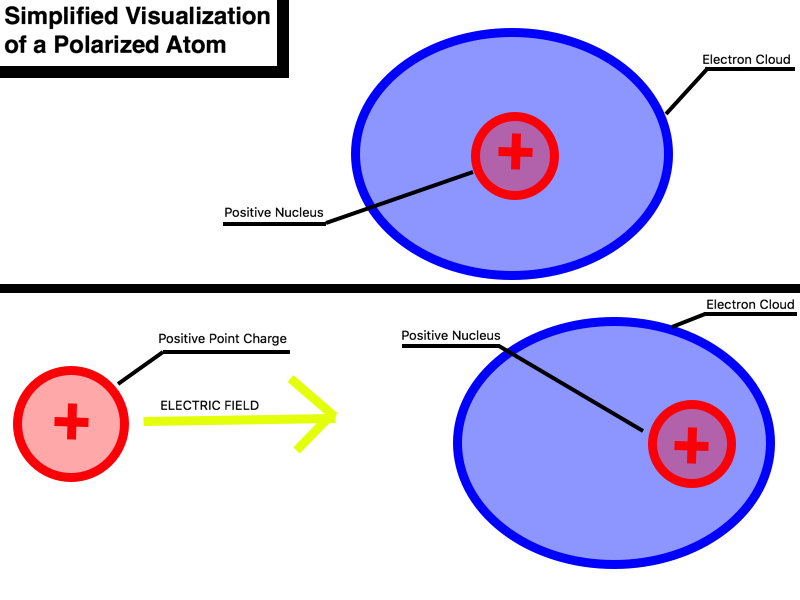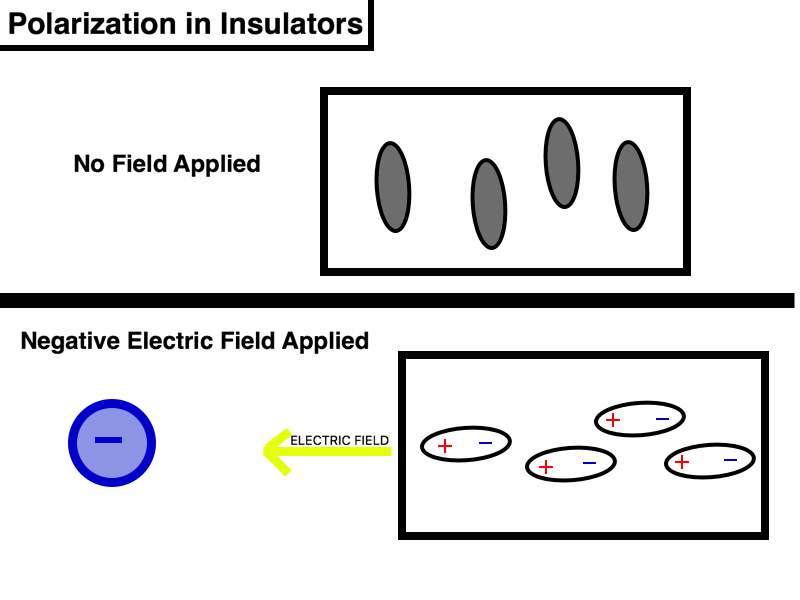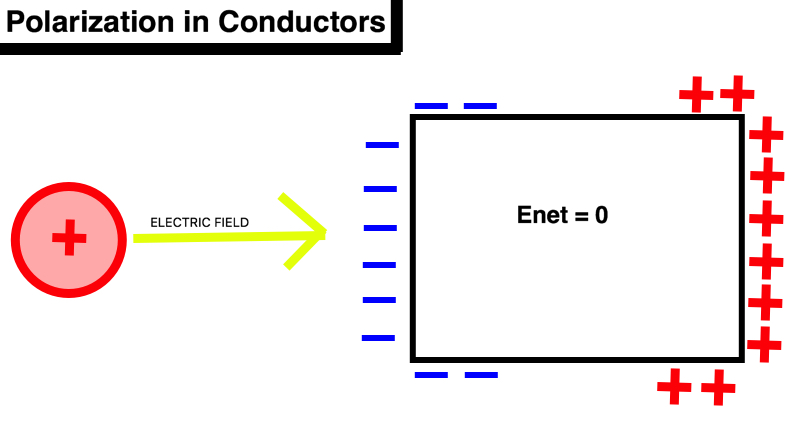Polarization
Short Description of Topic Made By: tkapadia3 aka Tapas Kapadia
The Main Idea
At an atomic level, external charges cause subatomic particles to restructure in way that is can be described as polarization. For example, a positive charge will create an outward field which will move the average electron position closer to the positive charge and the nucleus further away. Through this process of polarization, charges or electric fields effectively make neutral object induced dipoles. Polarization explains the attraction between charged objects and neutral object. A charged object creates an electric field that causes the opposite sign charge closer which in turn causes a net attraction. How readily a charged object can cause a material to polarize or the polarizability is different for different materials. The amount of polarization or the dipole moment is equal to the the polarizability multiplied by the electric field applied. The two main type of material are insulators and conductors and each of these handles polarization in a different way. It is important to understand that polarization itself does not induce charging. Polarization is the redistribution of charges throughout an object; a polarized neutral object is still a neutral object regardless of whether it is an insulator or conductor.
Polarization in Insulator: One main property of insulators is that electrons are tightly bound to the molecules. Therefore, there is no "sea of electrons" and the polarization happens much like what is shown below in which the actual atoms do not move very much but rather just reorient themselves to point correspondingly to the charges on or in the insulator. The net electric field is not equal to zero in the an insulator if there is a net electric field acting upon it.
Polarization in Conductors: Polarization in conductors differs from polarization in insulators because conductors have charged particles that can move throughout the object. While insulators have atoms that simply reorient themselves, conductors have charged particles that can move distances due to external charges applied upon the material. The speed in which these mobile charges move due to an applied electric is known formally as drift speed. The drift speed is equal to the the net electric field at the location of the charge multiplied by a the mobility of the mobile charges. Another important property of conductors is that excess charges are always located out the outside on the surface of the conductor. Because the polarization causes the mobile charges to reorient on the surface, the net electric field always goes to zero. This state is known as equilibrium, and it features a electron drift speed equal to 0. The electric field of the polarization of the charges cancels out the electric field applied which which leaves no net electric field inside a conductor when it is at equilibrium.
A Mathematical Model
Electric Force: [math]\displaystyle{ \vec{F} = q\vec{E} }[/math] Where "F" is the electric force, "q" is the charge, and "E" is the electric field.
Dipole Moment: [math]\displaystyle{ \vec{P} = \alpha \vec{E} }[/math] Where "P" is the dipole moment, alpha is the polarizability (different for every material), and "E" is the applied electric field.
Drift Speed: [math]\displaystyle{ \vec{v} = \mu E_{net} }[/math] Where "v" is the drift speed, mu is the mobility of the charge, and "Enet" is the magnitude of the net electric field.
What are the mathematical equations that allow us to model this topic. For example [math]\displaystyle{ {\frac{d\vec{p}}{dt}}_{system} = \vec{F}_{net} }[/math] where p is the momentum of the system and F is the net force from the surroundings.
A Computational Model
How do we visualize or predict using this topic. Consider embedding some vpython code here Teach hands-on with GlowScript
Examples
Be sure to show all steps in your solution and include diagrams whenever possible
Simple
Does a negatively charged rod cause the metal sphere to polarize? If so, show the polarization of the neutral metal sphere, describe the electric field, and electric force caused by the negatively charged rod displayed below.
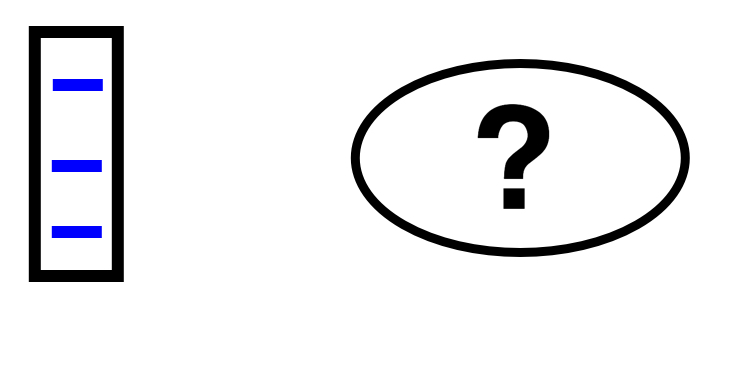
The electric field is toward the negatively charged rod. The electric force is pointed toward the charged as well. Thus the negative mobile charges are pushed to the surface of the far side of the sphere. The polarization essentially makes one giant dipole which has a net electric field of zero inside the sphere.
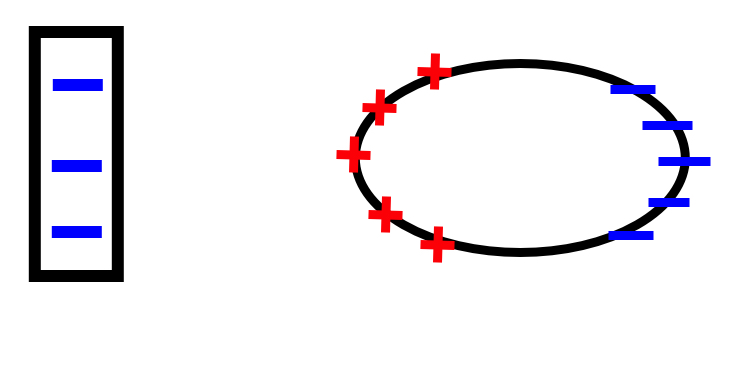
Middling
Find the direction of the net electric field at each point. Describe each electric field that is acting to create the net electric field. The square is a insulator while the sphere is a conductor.
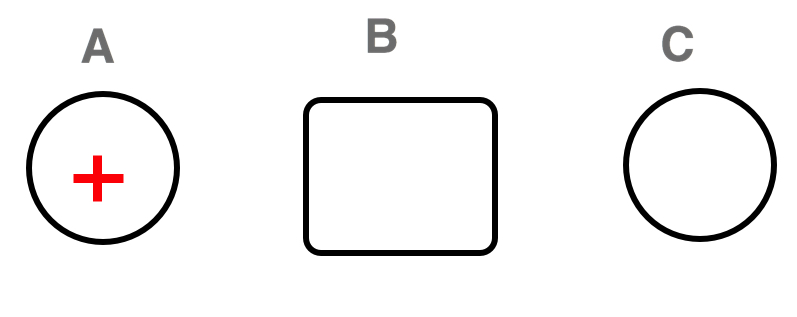 The net electric fields are shown below. There is no net electric field at location B because the mobile charges move to the surface of the sphere and
The net electric fields are shown below. There is no net electric field at location B because the mobile charges move to the surface of the sphere and
Difficult
Connectedness
- How is this topic connected to something that you are interested in?
- How is it connected to your major?
- Is there an interesting industrial application?
History
Put this idea in historical context. Give the reader the Who, What, When, Where, and Why.
See also
Are there related topics or categories in this wiki resource for the curious reader to explore? How does this topic fit into that context?
Further reading
Books, Articles or other print media on this topic
External links
Internet resources on this topic
References
This section contains the the references you used while writing this page
